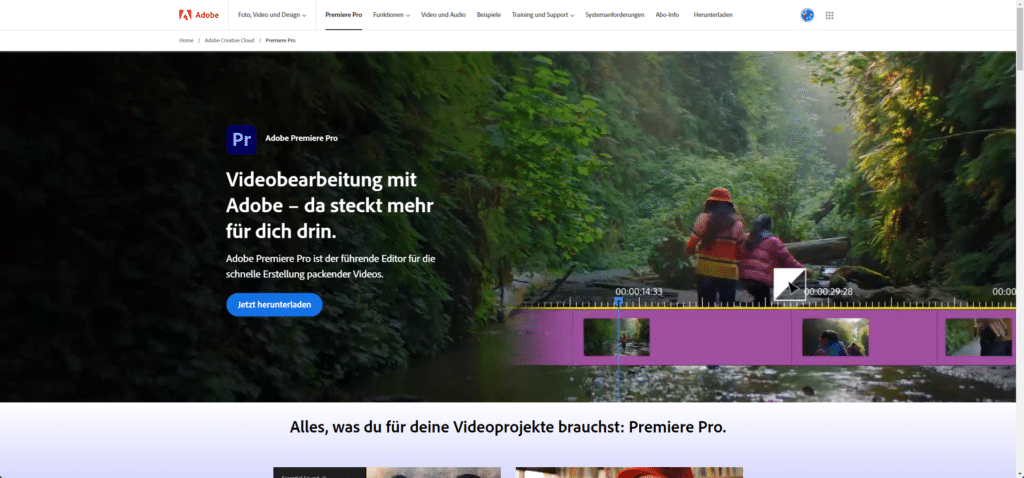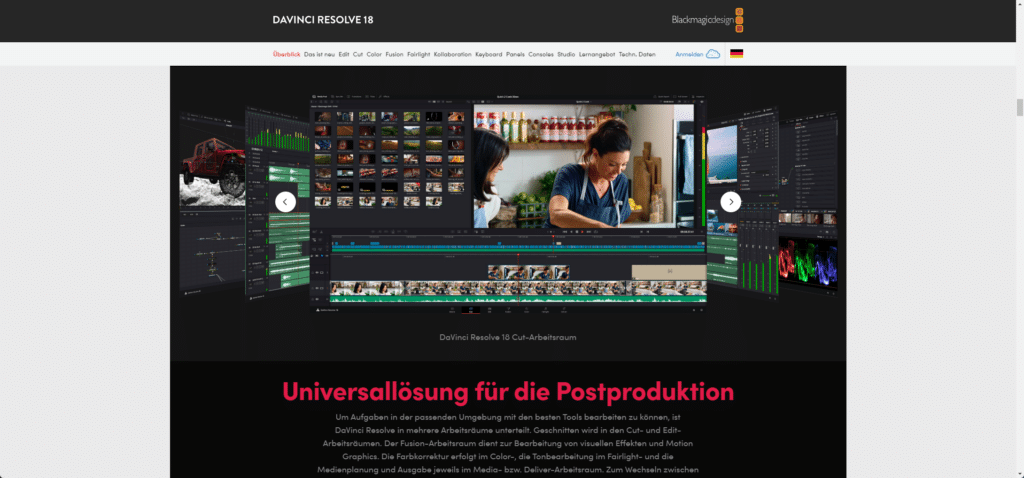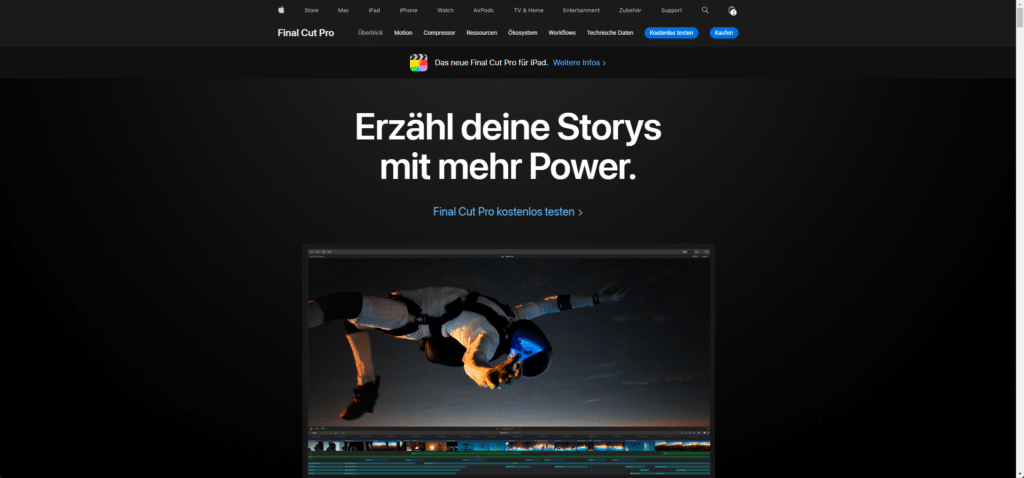Becoming self-employed as a cutter and earning a living from it requires a strategy and a clear understanding. In this guide, I will walk you through the steps required to become a successful career as an editor to build. From developing your skills to marketing yourself and building an impressive portfolio, I'll show you what it takes to achieve your goals.
Welcome to our guide for aspiring editors. Here's how you can thrive in this fascinating and competitive industry.
What you need to become a cutter
Here is a basic list of requirements:
- Knowledge of editing software: Learn how to use professional editing programs such as Adobe Premiere Pro, Final Cut Pro or DaVinci Resolve. search yourself one Choose the software you use and learn to perfect it.
- Creative thinking: Develop an understanding of narrative structure and visual aesthetics to effectively convey a story. Tip: Get inspired on YouTube (through videos)
- Good equipment: Invest in a powerful computer, high-quality monitors, and a reliable internet connection. More on that later.
- Portfolio: A portfolio shows your previous work. Build a portfolio of your best work to show potential clients or employers your skills.
- Networking skills: Networking is very important. Make contacts in the industry to get work and learn from other professionals.
- Self-marketing: Create a website or social media presence to promote your services and attract new customers. More on this later.
- Continuous training: Stay up to date with new technologies and trends in editing and constantly improve your skills.
Choosing the right equipment/software
In this section I explain what software (+ equipment) you need to turn your passion into a career.
The right video editing software
There are many video editing programs. I will show you the three most used - and therefore the biggest in the industry. Which one you use is of course entirely up to you. I personally use Davinci Resolve.

Adobe Premiere Pro: An extremely versatile and powerful editing program used by professional editors around the world. It offers a wide range of features for video and audio editing, as well as integration with other Adobe products such as After Effects and Photoshop.

DaVinci Resolve: A comprehensive solution that includes not only video editing but also color correction, audio post-production and visual effects. DaVinci Resolve offers a free version with limited features as well as a paid studio version with extended features.

Final Cut Pro: Exclusive to Mac, Final Cut Pro is known for its ease of use and efficiency. It offers similar features to Premiere Pro and is widely used by professional video editors working with Apple products. Only works for Mac.
There are of course many other programs (e.g. VegasPro) – Each software solution has its own advantages and disadvantages, and the choice often depends on personal preferences, workflow requirements and budget. Find out for yourself which software is right for you.
Attention: The choice of software usually takes place once. So keep this in mind, because getting used to new software later requires a lot of time as you have to get used to it. I know this too because I make music and have tried to replace my software with another one).
Equipment you need

- computer: A powerful computer is essential for smooth video editing. Your computer must have enough RAM, a powerful graphics card, and enough storage space to work efficiently with large video files.
… Danger: Here it is very important to choose whether you want to work on Mac or Windows. Final Cut Pro only works on Mac. - Monitors: High-resolution monitors with accurate color reproduction are important so that your videos are displayed correctly. Calibrated monitors are especially important when doing color grading. However, I won't go into this in more detail because I'm not familiar with it.
- external hard drives: Use external hard drives to backup and store video files to free up space on your main computer and ensure the security of your data. Good and fast hard drives are very important, always make sure you use a backup system. It would be annoying if your hard drive were to wear out at some point.
The choice of equipment should be based on your individual needs, budget and the requirements of your projects. It is extremely important to invest in both high-quality software and reliable hardware in order to work efficiently and professionally.
Building your portfolio

Now I'll explain to you how to build a portfolio. But first let me define the word:
What is a portfolio? A portfolio is a compilation of work or projects that a person has created to showcase their skills, experience and achievements. Typically, a portfolio consists of a selection of examples or samples of work intended to demonstrate the range and quality of a person's work. You need a portfolio to give potential customers, employers or clients an insight into your skills and styles.
In short, you need a portfolio so that clients can see what you deliver. Many people could claim to be editors (almost anyone with a smartphone can do that these days)... but perfection is the art. With a portfolio you can show what you can do and convince the customer to book you.
I will now explain to you how to build an online portfolio.
Therefore an online portfolio: It's available everywhere, you just have to send the link (or print QR code) and people can easily find you and view samples of your work.
Step 1: Choosing the platform
Choose a platform for your online portfolio. There are various options such as website builders, portfolio hosting sites or even social media platforms. Popular options include WordPress, Squarespace, Wix, Behance, and Adobe Portfolio. You can also simply upload your videos to a separate YouTube channel.
Step 2: Selecting the content
Select the videos you want to include in your portfolio. Be sure to showcase only your best work and offer a diverse selection to show the range of your skills.
Step 3: Design and layout
Design an attractive and user-friendly layout for your portfolio. Choose a clean and professional design that will showcase your work in the best possible way. Make sure it is easy to navigate and has a clear structure so that visitors can easily navigate through your portfolio.
Step 4: Integration of multimedia content
Integrate multimedia content such as videos, images, audio files or interactive presentations to make your work more lively and engaging. Make sure that the media is presented in high quality and that it works well on different devices.
Step 5: Add descriptions and contact details
For each project or work sample, add meaningful descriptions that explain the context, your role, and the techniques or tools used. Make sure your contact information is clearly visible so potential clients or employers can easily reach you.
It all sounds more complicated (and time-consuming) than it is. In short:
- Selection of platform:
- Choose a suitable platform such as WordPress, Squarespace, Wix, Behance or Adobe Portfolio for your online portfolio. Alternatively, you can create a separate YouTube channel for your videos.
- Selection of content:
- Carefully select your best videos to include in your portfolio. Make sure the selection showcases a wide range of your skills and styles.
- Design and layout:
- Design an attractive and user-friendly layout for your portfolio. Make sure you have a clear structure and easy navigation so that visitors can easily navigate through your work samples.
- Integration of multimedia content:
- Incorporate videos, images, and other multimedia content to make your work more vibrant and engaging. Make sure the media is presented in high quality and works well on various devices.
- Descriptions and contact details:
- Add meaningful descriptions to each video that explain the context, your role, and the techniques used. Make sure your contact information is clearly visible so potential customers can easily reach you.
Networking and self-marketing
That's why it's important: You should maintain good contacts in an industry. And if you don't have these yet, then you should build up these contacts. Because through this you increase your industry value and become known. So you get orders.

I'll explain to you in a short text how you can make contacts and market yourself:
- Build networking:
- Attend industry events, networking events, and conferences to meet other professionals in the industry. If well-known YouTubers are hosting an event, go.
- Use online platforms like LinkedIn to get in touch with other editors, filmmakers and potential clients.
- Be active in professional groups or forums to expand your network and learn from others. Interact with people - this is very, very important.
- Self-marketing:
- Create a professional website or social media profiles to showcase your services and share work samples. Instagram, TikTok and your own website.
- Be active on social media by regularly sharing content, participating in discussions and demonstrating your expertise. Show them what you've got. Explain it to people.
- Use personal recommendations and customer reviews to gain the trust of potential customers and strengthen your credibility.
Practical Experience – Getting Started
Practical experience is crucial for aspiring editors to improve their skills and establish themselves in the industry.
- Internships: Look for internships in film studios, production companies or post-production houses to gain insights into the professional working methods and to gain practical experience.
- voluntary work: Offer your services for free to nonprofits, student projects, or local film crews to gain hands-on experience while doing good.
- Freelance assignments: Accept unpaid or low-paying jobs on platforms like Fiverr, Upwork or Freelancer to practice your skills, build your portfolio and collect initial references.
- Own projects: Start your own film or video projects to improve your editing skills and implement creative ideas. This can also be a great way to develop your working method and style.
- Practice with personal projects: Edit videos for friends, family, or local businesses to gain hands-on experience while expanding your portfolio.
Of course, it's frustrating when you invest a lot of time and effort and get little or no money in return. But this is often unavoidable, especially at the beginning of your career. It's okay to take unpaid or low-paying jobs initially to gain experience and build your portfolio. However, it is important to make sure that you do not sell yourself short in the long term.
These early experiences are valuable for improving your skills and establishing yourself in the industry. But remember that you should value your time and skills. Set clear boundaries and strive for assignments that appropriately reward your worth. With time and experience, you'll be able to adjust your prices accordingly and focus on more lucrative projects. For example, you can start accepting orders with Fiverr:

Fiverr is a marketplace for freelancers like you want to become. You can get orders there.
Important: Stick with it and work, work, work.
The power lies in continuity. That means: Keep going!
In order to build a successful career as an editor, endurance and persistence are extremely important. It's super important to continually work on your skills, learn new techniques and expand your portfolio. Be prepared to accept challenges and learn from mistakes, because every assignment offers the opportunity to develop and grow.
When it comes to career paths, editors have various options available to them:
- Freelance work: As a freelancer, you have the freedom to choose your own projects and set your own working hours. However, this also requires a high level of self-management and the ability to market yourself.
- Employment in studios or agencies: By working in a studio or agency, you can benefit from a stable income, resources and support from experienced colleagues. This can be a good option to gain experience and establish yourself in the industry.
- Founding your own studio: If you are entrepreneurially inclined, you can start your own studio and realize your own projects. However, this requires not only technical knowledge but also business acumen and management skills.
For long-term career planning, I recommend:
- Specialization in certain genres: Find out what type of video editing suits you best and specialize in it. Whether it's feature films, documentaries, commercials or music videos - specializing can strengthen your market position and set you apart from the competition.
- Entering into partnerships: Look for opportunities to collaborate with other professionals in the industry, be it directors, producers, cinematographers or sound engineers. Partnerships can open up new professional opportunities and help expand your network.
Did the instructions help you? If yes, leave a like and comment.



